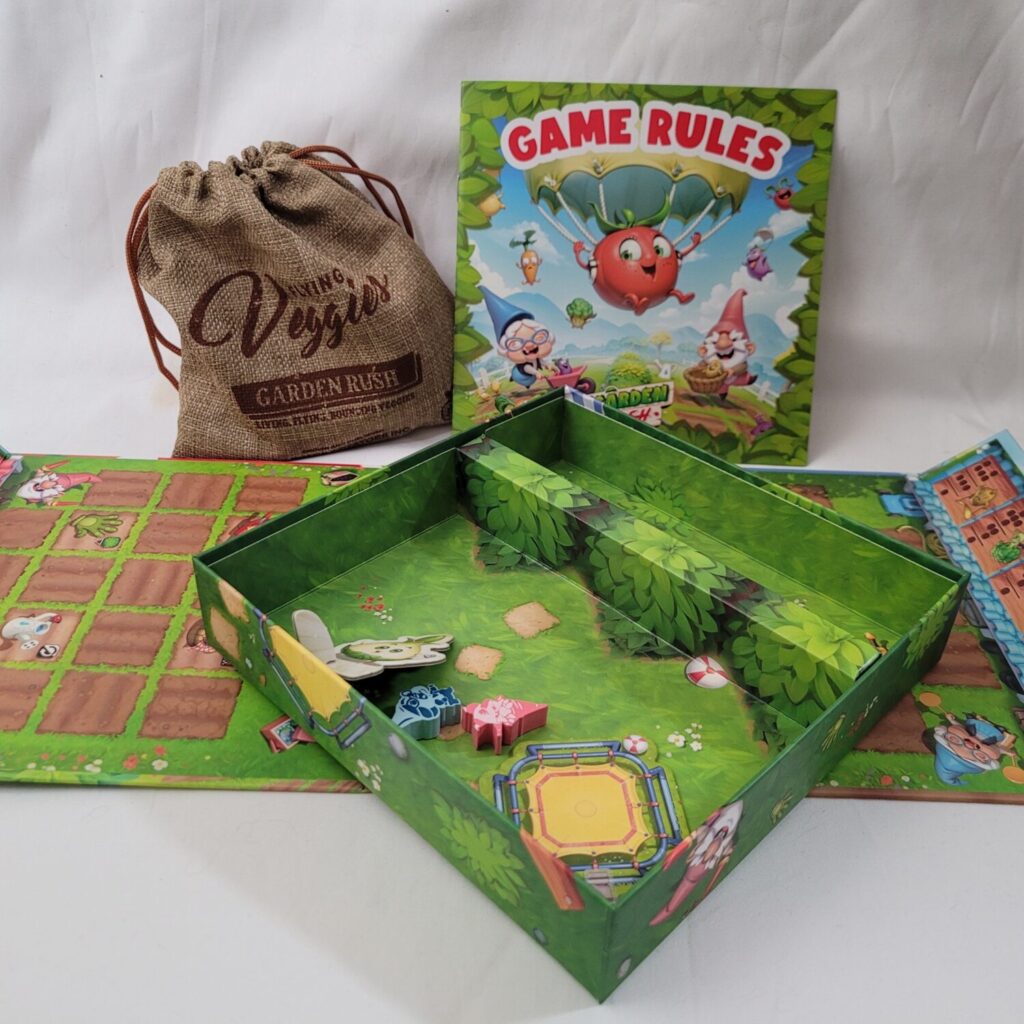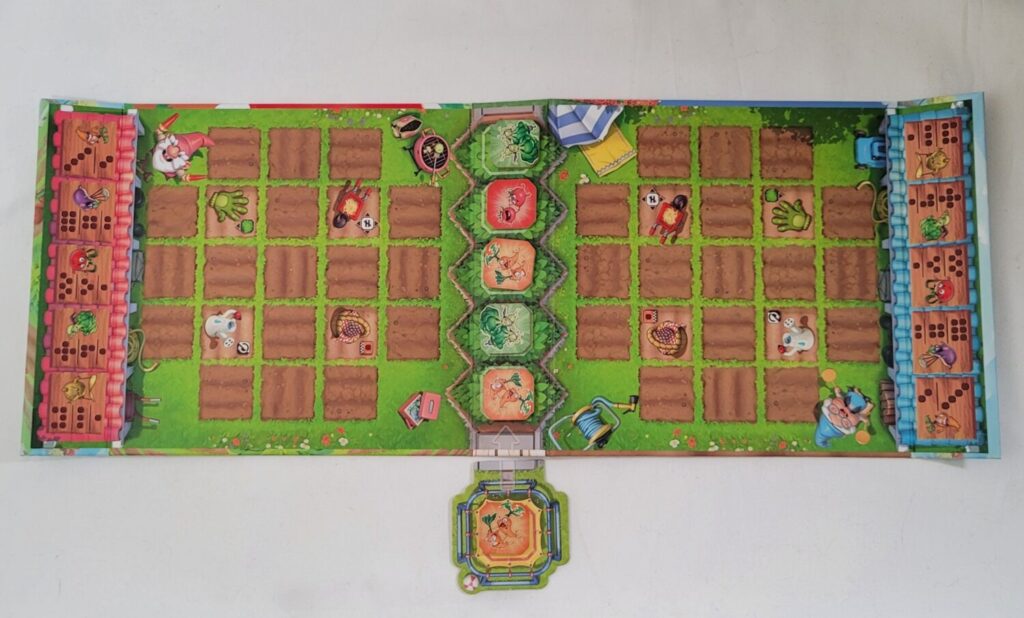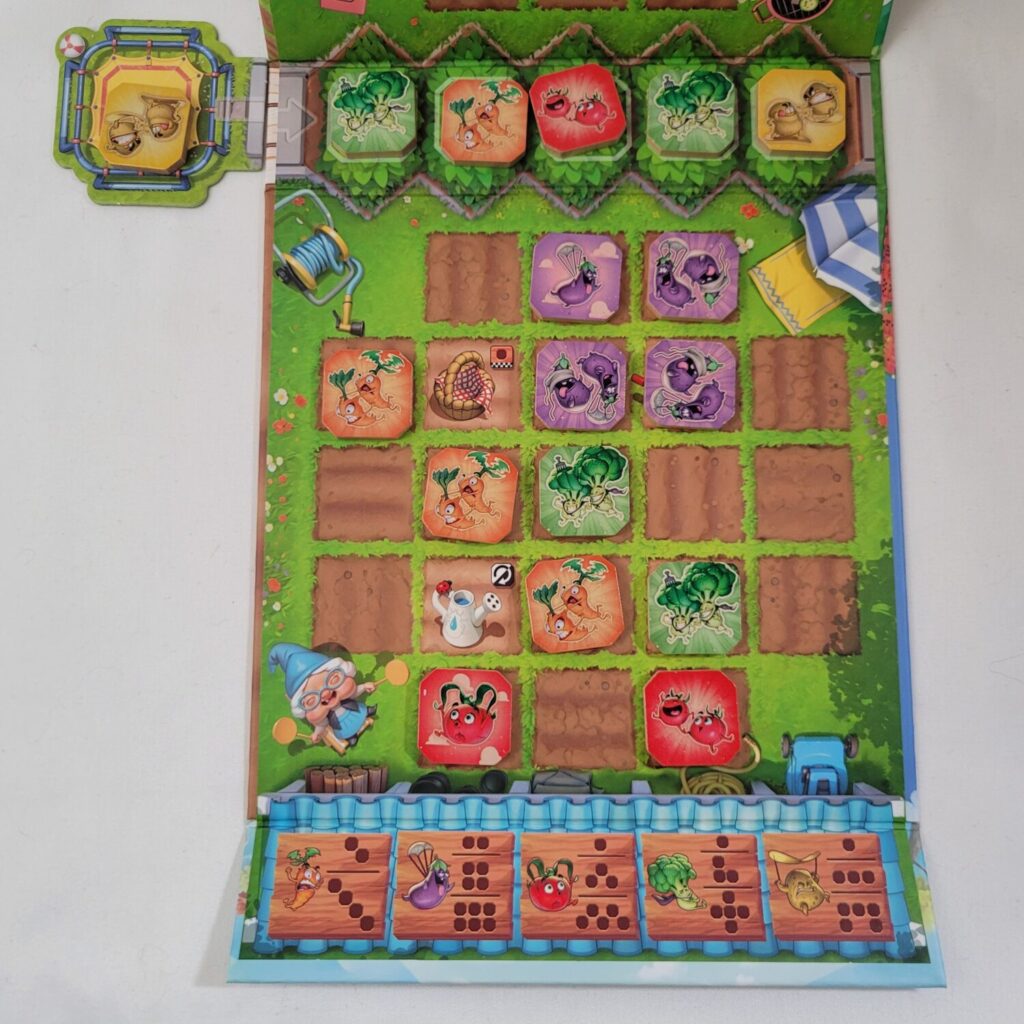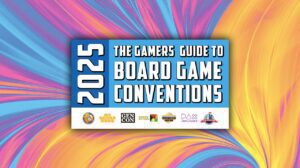Disclosure: Meeple Mountain received a free copy of this product in exchange for an honest, unbiased review. This review is not intended to be an endorsement.
Garden Rush (designed by Ki Mansell) is a lightning fast, tile-drafting, tableau-building game, for two players, about planting vegetables and harvesting those vegetables for points. The game comes packaged in an open box enveloped by a clamshell cover that’s held shut via magnets. This clamshell folds open to reveal the playing area. The box serves double duty as well: a storage mechanism and, when flipped over, the game’s score board on which the players’ gnome figures are placed.

The players sit at opposite ends of the game board, which is divided into two identical gardens with a hedge running between them. During setup, vegetable tiles are drawn from the bag and placed on each space of the hedge, double vegetable side up. Each garden is arranged in a 5×5 grid with the corners cut off, forming an inner square. At the corners of this square are four icons representing special actions the players can perform when these icons are covered by tiles. These actions let you claim an extra tile from the lineup, harvest (i.e. score) a veggie bed in your garden, move a tile from one location to another, or flip any veggie in either player’s garden to its opposite side.
Each space of the hedge lines up with a column of spaces in your garden. On your turn, you’ve got two options: take a tile or harvest (a.k.a. score). If you take a tile, you can place it double veggie side up into the column matching the hedge location from which it was taken, or you can place it single veggie side up in some other column. Once a hedge space becomes empty, the remaining vegetables shift to fill in the empty spot, a new vegetable is placed at the end of the line, and a new vegetable takes its place on the trampoline.

Yes, you read that right. Trampoline. In Garden Rush, not only are the anthropomorphic vegetables smiling at you, they’re seemingly so eager to be cut down and ingested that they are literally leaping at the opportunity.
Why Does All This Matter?
In Garden Rush, each vegetable type has multiple patterns in which they can be planted. Once you’ve planted them into one of their patterns, they can be harvested for a number of points equal to however many plants the pattern was composed of. When harvested, double veggie tiles get flipped to their single veggie sides, and single veggie tiles get removed from the board.
If that sounds a little funky, consider the carrot. Carrots can be harvested once you’ve planted either two or four of them diagonally adjacent to one another. If you harvest two carrots, then you earn two points. If you harvest four, you get four points. There’s not much more to it.

These points are important for two reasons. Firstly, there are certain breakpoints along the score track which, if you manage to end your turn with your gnome on top of them, allow you to perform a bonus action (potentially chaining bonuses if you’re clever enough). Secondly, and most importantly, Garden Rush isn’t just about scoring points. It’s about scoring 40 points, and it’s about scoring those points before your opponent can do the same. Once a player scores 40 points, the round is finished and whoever has progressed the furthest along the scoretrack wins. Otherwise, the game ends once the bag runs out of tiles and whoever has scored the most points up to that point wins.
A Lovely Stew
There’s a lot to like about Garden Rush. The rules are easy to teach and digest. Within minutes, you’ll be up and running without any problems. The game is small and, with experienced players, only takes 20-30 minutes to play: perfect for tossing into a backpack to be played with a co-worker during your lunch break. The artwork, while absurd, is cheeky and fun. The component quality is top notch.
The game play is pretty stellar, too. Garden Rush is a game all about balancing long term goals with short term gains. Do you intentionally score fewer points so that you won’t overshoot a checkpoint on the scoring track, or do you forgo the extra action in order to score more points? And, when it comes to drafting vegetables from the hedge row, figuring out how to arrange your vegetables to make other types of vegetables fit can be quite a challenge. This aspect of the game always reminds me of Tiny Towns in the way that you’re tasked with setting up various objects in a confined space to capitalize on scoring opportunities when they come along.
The game’s pacing is pretty much perfect. Things start out slowly. With a mostly empty garden, it’s easy to relax and just enjoy the ride. But, as your garden begins to fill, things become more lively. The tension builds as your little gnome scoring markers jockey for position on the scoring track. The energy becomes palpable. Garden Rush is, in a word, invigorating.
My only real beef with this game is the packaging. While I applaud the engineering of the removable sleeve to serve as the game’s playing area, it creates a situation where the box with the actual contents of the game always tries to slide out if you happen to pick the game up the wrong way. I wish the sleeve were magnetically attached to the inner box in some way to prevent this because having the box try to slide out every time I pick up the game is REALLY annoying.
This small annoyance does nothing to sully my enjoyment of the game, however. Garden Rush checks a lot of boxes for me, and it’s become a game that pretty much permanently lives in my backpack, ready to be pulled out and set up at a moment’s notice. If you’re in the market for a two-player game that’s easy to set up and tear down, that’s quick and easy to play, but still presents a challenge, Garden Rush just might be what you’re looking for.












